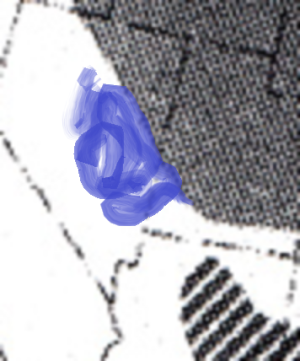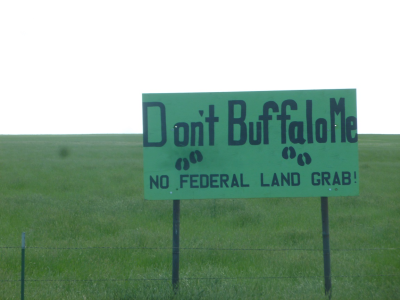This article discusses the Lewis and Clark's account of elk along their route. Which is far north from where I live.
 lewis-clark.org
lewis-clark.org
It concludes that plains (rangeland) and woodlands are habitat for elk, and suggests that according to early accounts elk are more at home in the woods. This still being a debate among biologists today.
The pre-euro range of elk according to the Wildlife Management Institute.

Using the diaries of explorers and early settlers is great way to determine what's missing and what went where. Another method that covers a far greater time period is archeological surveys and diggings; bones found in habitation sites, rock art, pack rat middens, etc. Another is to look at the vegetation communities.
I can only speak to my backyard and RM elk, but this is today's range of elk based on repeated first hand aerial and ground surveys. Note that there is no empirical evidence showing that wolves inhabited any of the blue area and many parts of the black stippled area. All elk within the blue area are artificial and planted in the 1950s, as are a number of herds in the black stipple.

Controlling elk populations requires culling, deep into their historical habitat. Private property restricting hunting access is often the reason given for an unsustainable population.

 www.outdoorlife.com
www.outdoorlife.com
I know from firsthand experience that regulated (and a a bit of unregulated) hunting by individuals does not keep a population in check. I have watched over the past 35 years elk hunter numbers increase, weapons continue to improve, tactics continue to improve, and the elk numbers keep growing. Never once in my area have they ever had to back off the numbers of tags sold, and they continue to increase. This year was large increase, due to my own bitching and bitching of others. I don't see it making a dent yet. I guess we don't bitch as loud as "The Church." We need commercial harvesting.
So with no evidence of historic or prehistoric elk occupation, and or no evidence of wolves or other predators, what keep elk in check in many of these areas elk supposedly occupied pre-white man? I have seen evidence of elk in rock art where there are no elk today (6-8" precip zone), and a lack of evidence in rock art where elk are today. Surely they would be depicting these things and they seem to most other megafauna.
Now, just for shits and giggles, think about the fact that the blue area in the map above is occupied by approximately 35,000 feral (wild) horses. They make any elk problems unnoticeable.
One thing many biologists fail to recognize is the change in climate in my region over the past 20,000 years, and especially the past 1,600. The simply way to view this is a latitudinal shift in vegetation to the north, but restricted in some places by geology. The animals shift with it.
American Elk - Discover Lewis & Clark
One of the staple foods of the Lewis and Clark Expedition was the wapiti, or American elk with a population of 10 million at the time.
It concludes that plains (rangeland) and woodlands are habitat for elk, and suggests that according to early accounts elk are more at home in the woods. This still being a debate among biologists today.
The pre-euro range of elk according to the Wildlife Management Institute.
Using the diaries of explorers and early settlers is great way to determine what's missing and what went where. Another method that covers a far greater time period is archeological surveys and diggings; bones found in habitation sites, rock art, pack rat middens, etc. Another is to look at the vegetation communities.
I can only speak to my backyard and RM elk, but this is today's range of elk based on repeated first hand aerial and ground surveys. Note that there is no empirical evidence showing that wolves inhabited any of the blue area and many parts of the black stippled area. All elk within the blue area are artificial and planted in the 1950s, as are a number of herds in the black stipple.

Controlling elk populations requires culling, deep into their historical habitat. Private property restricting hunting access is often the reason given for an unsustainable population.

Utah Officials Secretly Culled 170 Elk on Church-Owned Deseret Land
State officials say the cull was necessary to bring elk numbers more in line with the agency's population objectives.
 www.outdoorlife.com
www.outdoorlife.com
I know from firsthand experience that regulated (and a a bit of unregulated) hunting by individuals does not keep a population in check. I have watched over the past 35 years elk hunter numbers increase, weapons continue to improve, tactics continue to improve, and the elk numbers keep growing. Never once in my area have they ever had to back off the numbers of tags sold, and they continue to increase. This year was large increase, due to my own bitching and bitching of others. I don't see it making a dent yet. I guess we don't bitch as loud as "The Church." We need commercial harvesting.
So with no evidence of historic or prehistoric elk occupation, and or no evidence of wolves or other predators, what keep elk in check in many of these areas elk supposedly occupied pre-white man? I have seen evidence of elk in rock art where there are no elk today (6-8" precip zone), and a lack of evidence in rock art where elk are today. Surely they would be depicting these things and they seem to most other megafauna.
Now, just for shits and giggles, think about the fact that the blue area in the map above is occupied by approximately 35,000 feral (wild) horses. They make any elk problems unnoticeable.
One thing many biologists fail to recognize is the change in climate in my region over the past 20,000 years, and especially the past 1,600. The simply way to view this is a latitudinal shift in vegetation to the north, but restricted in some places by geology. The animals shift with it.
Last edited:

